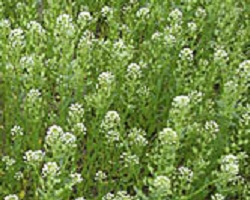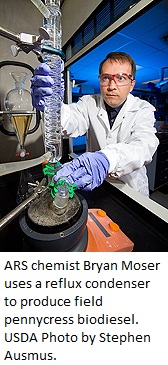 The USDA is looking into turning a common weed into biodiesel.
The USDA is looking into turning a common weed into biodiesel.
Researchers with the Agricultural Research Service (ARS) have found that field pennycress, better known in some circles as stinkweed, puts out a large amount of oilseeds good for making the green fuel:
Field pennycress belongs to the Brassicaceae family, along with canola, camelina and mustard-other prolific producers of oil-rich seeds. The ARS studies help support USDA’s efforts to develop new sources of bioenergy.
 At the ARS National Center for Agricultural Utilization Research in Peoria, Ill., chemists Bryan Moser, Gerhard Knothe and Terry Isbell and plant physiologist Steven Vaughn formed a team to study field pennycress’ potential.
At the ARS National Center for Agricultural Utilization Research in Peoria, Ill., chemists Bryan Moser, Gerhard Knothe and Terry Isbell and plant physiologist Steven Vaughn formed a team to study field pennycress’ potential.
The scientists obtained oil from wild field pennycress, pretreated it with acid, and used a type of alcohol called methanol to react with the field pennycress oil to produce both biodiesel and glycerol. After some additional refining, the finished biodiesel was tested to see if it met the biodiesel fuel standard established by the American Society for Testing and Materials. The results suggested that, with some work, the previously problematic pennycress could become a commercial commodity.
The ARS goes on to say that pennycress oil is attractive for biodiesel because of its low cloud and pour points, 14 degrees Fahrenheit for clouding and for pour, well below the cloud and pour points of soybean oil-based biodiesel. In addition, pennycress can be grown in the winter and harvested in the late spring, allowing farmers to still have a summer soybean rotation.

